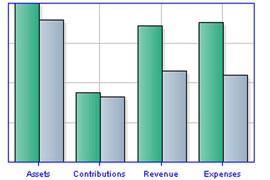Cronkite News has moved to a new home at cronkitenews.azpbs.org. Use this site to search archives from 2011 to May 2015. You can search the new site for current stories.
Phoenix charities get middling scores on national ranking of nonprofits
Editor’s Note: A previous version of this story failed to note that the Community Food Bank of Southern Arizona, while included in the Charity Navigator report on major metro areas, is located in Tucson. The story has been updated to reflect the correction.
WASHINGTON – Charities in the Phoenix area ranked 23rd among the nation’s 30 major metro areas for financial performance, accountability and transparency in 2013, according to a recent report.
Despite relatively strong revenues – the 60 Phoenix charities studied had average revenues of $7 million as of May 1, compared to a national average of $4.7 million – the area ranked last for financial health, as local expenses far outstripped the national average.
The report, Metro Market Study 2013, said the national average expense for the nonprofits it studied was $4.3 million, but Phoenix charities spent an average of $7.2 million from May 2012 to 2013.
The report put the Phoenix Symphony on its list of the 10 charities in deepest financial trouble in the nation, but symphony organizers said that ranking does not reflect a recent turn-around in their finances.
“The symphony is on track to break even, eliminating a nearly $3 million deficit in the past two years,” said Phoenix Symphony CEO Jim Ward, who said the organization is actually going through “a significant turnaround” this year.
There were bright spots in the report as well for Arizona charities: The Tucson-based Community Food Bank of Southern Arizona made it to the list of 10 “top-notch” charities for its overall performance on finances, accountability and transparency.
The annual report by Charity Navigator, a New Jersey-based nonprofit that evaluates U.S. charities, looks “to see if charities are growing their revenue and spending on program increase at about the same rate,” said Sandra Miniutti, chief financial officer for the organization.
Miniutti said it was clearly the financial picture that held Phoenix charities back in the rankings.
Area nonprofit executives conceded that finances have been tough as the region struggled through the recession, but they believe things are looking up.
“People in Phoenix are certainly giving more because they are feeling more secure,” said Jacky Alling, chief philanthropic services officer at the Arizona Community Foundation. The organization said it has invested $423 million into more than 21,000 charities in Arizona in its 35-year history.
Things are getting better, but “we are certainly not back at the level of giving that we were before the recession,” said Michael Nilsen, vice president of the national Association of Fundraising Professionals.
That’s true in Arizona as well.
“This year has been difficult because the economy is still struggling,” said Bill Carnegie, CEO at the Community Food Bank of Southern Arizona.
He said the reason the food bank is able to struggle through tough times is because of its decision “to really focus on programs to make sure that every dollar is used effectively.” The Charity Navigator study said as much, reporting that 96.9 percent of the food bank’s expenses were spent on programs over the last year.
Carnegie said the economic downturn has also increased competition between nonprofits as they fight for funding.
“It’s hard for donors to decide whom they want to support,” he said.
One possible solution is cooperation.
“Collaboration between nonprofit can help the donors’ dollars go further,” Carnegie said.
In some cases, the choice is being made for them, with “some funders … forcing nonprofits to collaborate more.”
The food bank partnered with more than 300 other nonprofits to make the most of every dollar to serve different programs. Carnegie said hunger is just one of the many problems people in poverty have and it is important for charities to work together, “to make a better place for citizens to live and raise families.”
Ward said the Phoenix Symphony has already seen the advantages of cooperation. It teamed up last July with Ballet Arizona and Arizona Opera, when the three arts organizations introduced an annual fundraising gala – Trio – that features ballet, opera and the symphony on stage together.
“Trio represents our latest efforts with other arts organizations to find new efficiencies and new ways to add value for the benefit of our patrons in these challenging times,” Ward said.
Ward said there is no getting around the fact that it costs money to run a symphony, with a high cost of daily operations and musicians’ salaries. But he said the Charity Navigator report did not include the symphony’s latest tax form 990, which shows better financials for the year.
Charles Berginc, principal trumpet for the Phoenix Symphony, agreed. The situation at the symphony now is “kind of the opposite” of what’s in the report, he said.
Berginc said the orchestra has made a variety of changes in concerts, and “has been very encouraged by the audience.”
Ward said his team works hard on marketing and adjusting to the audience.
“A nonprofit needs to be run like a business,” he said.










